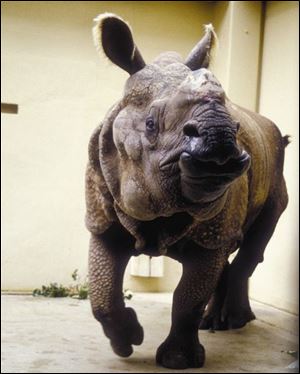
Zoo vets talk about the joys and problems of caring for animals
7/5/2008
A greater one-horned rhino who was a patient of Dr. Lucy Speiman.
My common childhood dreams of being a veterinarian never included climbing into a dry pool to get skin samples from a giant crocodile or giving a 3,000 pound hippopotamus a root canal.
Studying the MRI of a giant Pacific octopus and figuring out why a green moray eel wasn't eating never crossed my mind, either.
Those are a sampling of intriguing experiences shared in The Rhino With Glue-On Shoes: And Other Surprising True Stories of Zoo Vets and Their Patients. And those true stories go far beyond what many animal lovers typically imagine, offering glimpses of what happens beyond a zoo's barricades.
Edited by veterinarians Lucy Spelman and Ted Mashima, with a foreword by the Columbus Zoo's well-known Jack Hanna, the book contains 28 essays from wild-animal veterinarians worldwide. It includes a 16-page color insert with a photo of each featured animal or, if none is available, one of its species.
The book gets its title from the experience of a one-horned rhinoceros named Mohan at the Smithsonian National Zoological Park in Washington who was treated by Spelman. Mohan's feet repeatedly developed diseased tissue that had to be cut away, at times requiring anesthesia that Spelman feared could cause complications for her 5,000-pound patient.
When Spelman attended a lecture on wild rhinos, she realized Mohan's toenails were completely worn down from walking on hard ground in captivity. Another veterinarian suggested using epoxy to temporarily adhere aluminum shoes like those worn by horses and performed the task.
Mohan's nails grew out, although the chronic infection slowly returned and he was moved to a swampier exhibit in a warmer climate, Spelman writes.
Some stories take place in the wilds, not a zoo. Some prompt laughs, like one veterinarian's recollections of going into a drained pool with a fully awake crocodile or the thought of giving a hippo a root canal.
Other stories are heart-wrenching.
A giraffe named Amali whose mother accidentally stepped on her and dislocated her hip after birth would eventually die despite treatment. So would two rare sea dragons whose air bladders became overinflated during the move from Australia to Florida.
All of the essays involve veterinarians devoted to their patients, and to figuring out the best treatment methods. Wild-animal veterinarians must handle an array of barriers, including needing to observe aggressive or skittish animals from afar for safety reasons - and not being able to talk with their patients.
Turns out, zoo and wildlife veterinarians at times must rely on experiences of their domestic-animal counterparts and other scientists to find potential answers to medical dilemmas. And sometimes they need their assistance.
Getting radiological tests done of the giant Pacific octopus at the Baltimore Zoo, for example, required help from the Johns Hopkins School of Medicine, where zoo veterinarian Michael Stoskopf was on the faculty. An initial CT made Bertha's tissues look like a bag of Jell-O with banana slices, but an MRI helped rule out the presence of a mysterious, fatal syndrome and the need for brain surgery, Stoskopf wrote.
Human doctors also lend a hand to veterinarians in the book.
A kangaroo named Sally who was being chased by emus at the Audobon Zoo in New Orleans broke her neck running into a fence. A neurosurgeon realigned her spinal canal and repaired her vertebrae.
Other human interaction can help, too.
One visit from a bartender who donated a green moray eel to the New England Aquarium after it outgrew its tank next to the bar was all it took for the creature to start eating again. He hand-fed the eel, who never refused food again.
Veterinarians are not the only ones who appreciate wild animals, even if they have to settle for seeing them through glass and other barricades - or reading about them.
Contact Julie M. McKinnon at:
jmckinnon@theblade.com
or 419-724-6087.